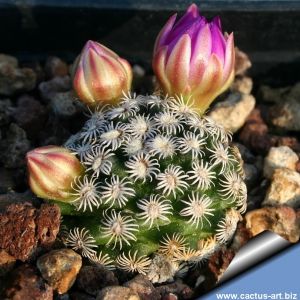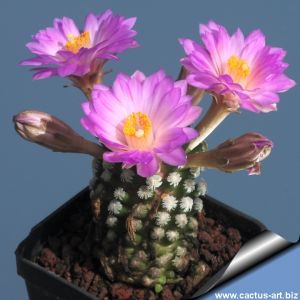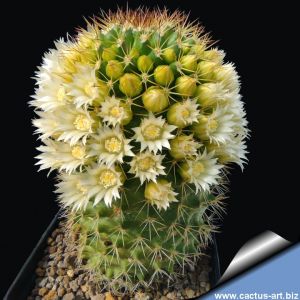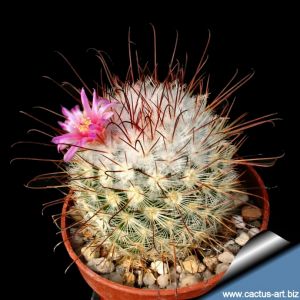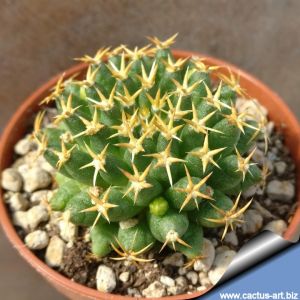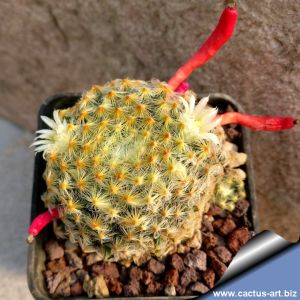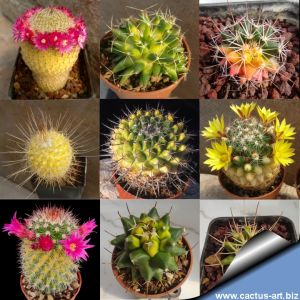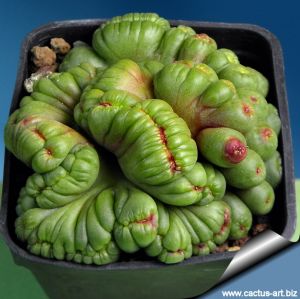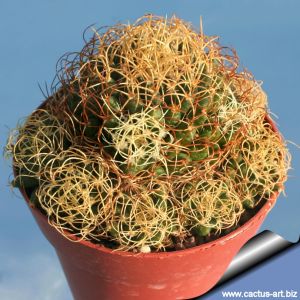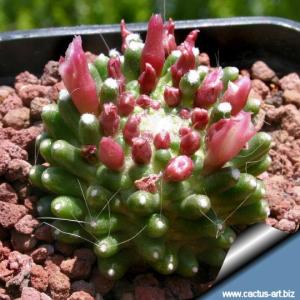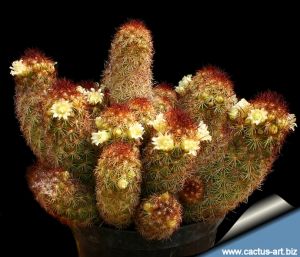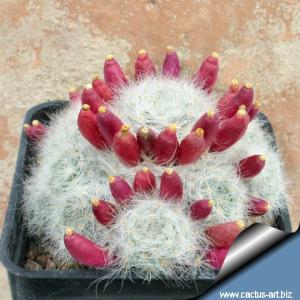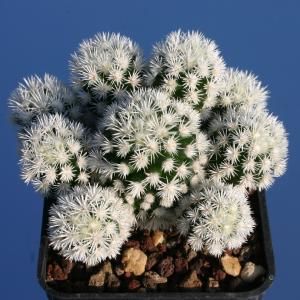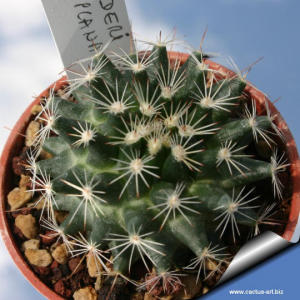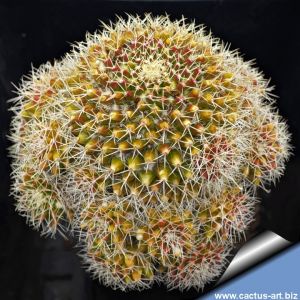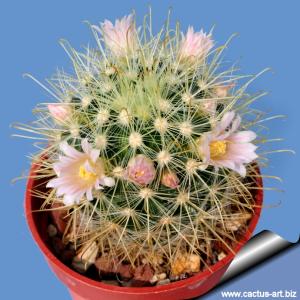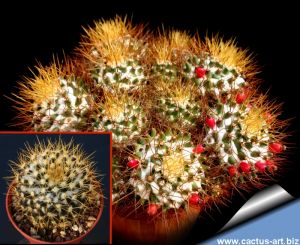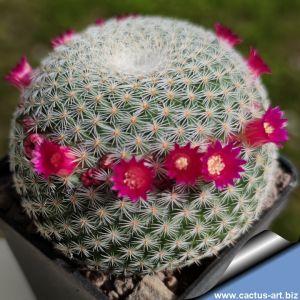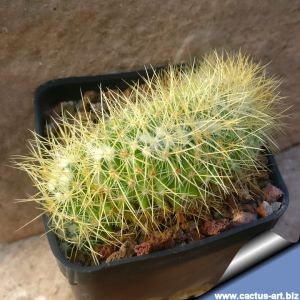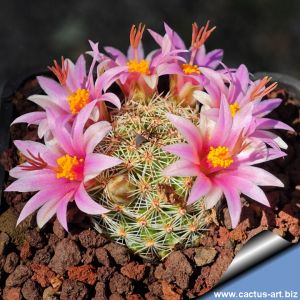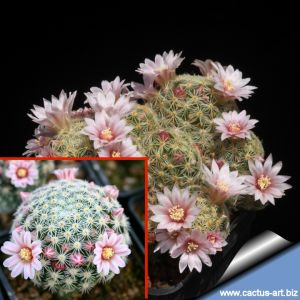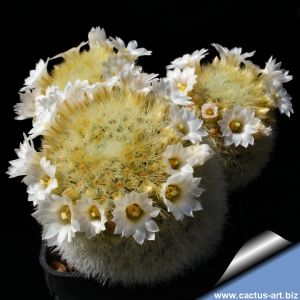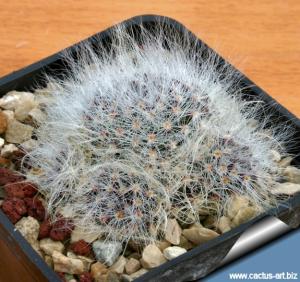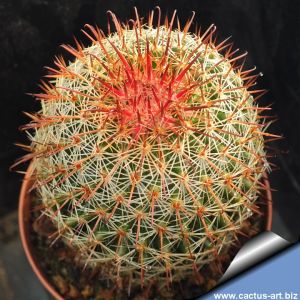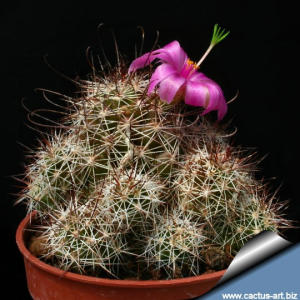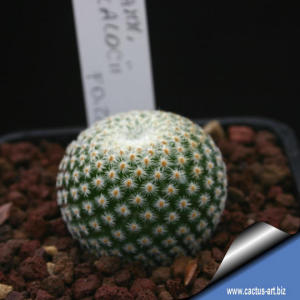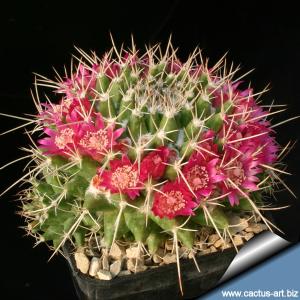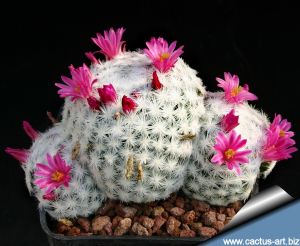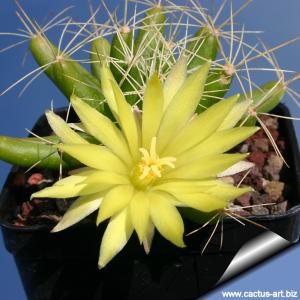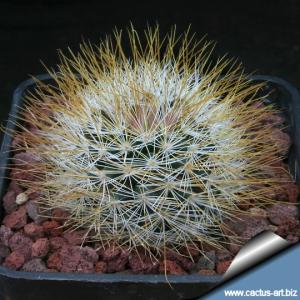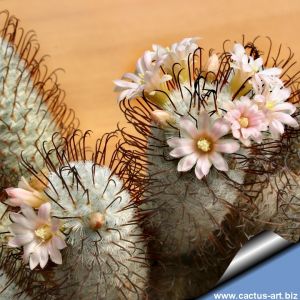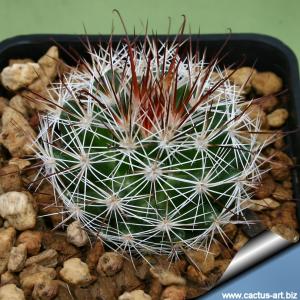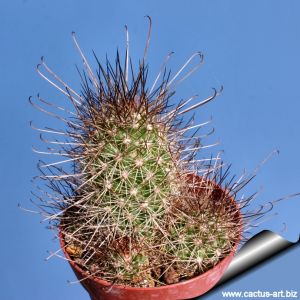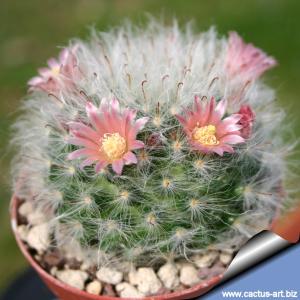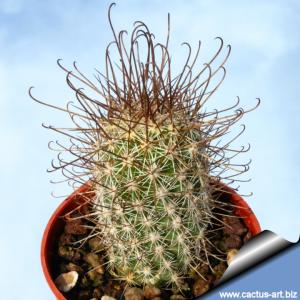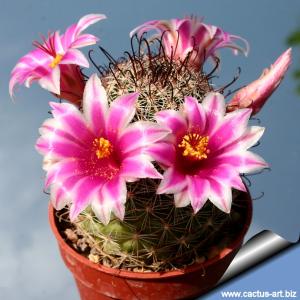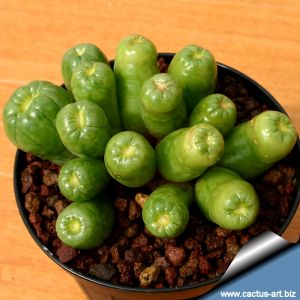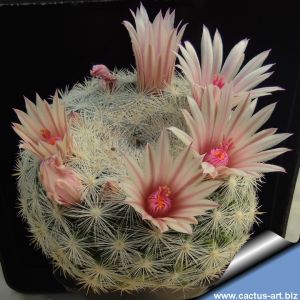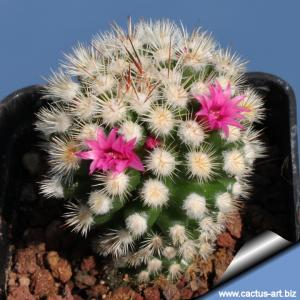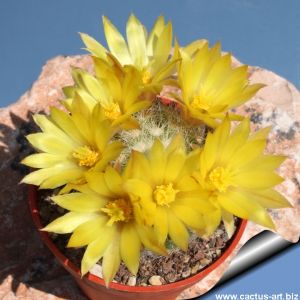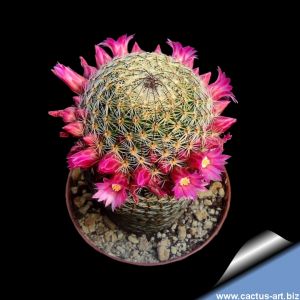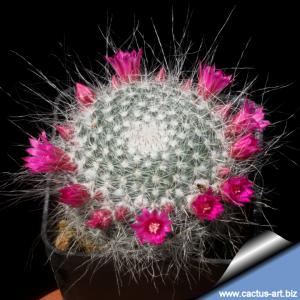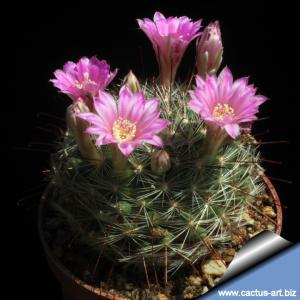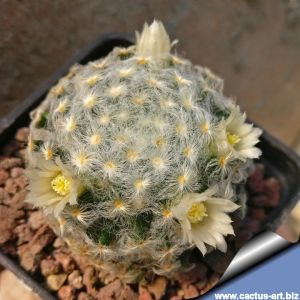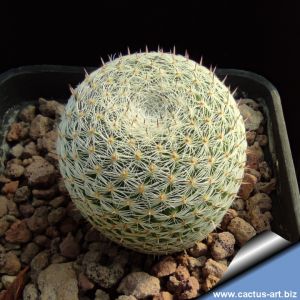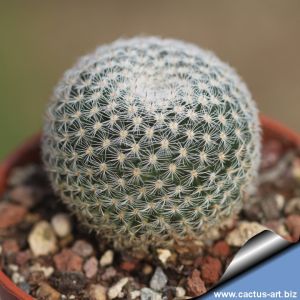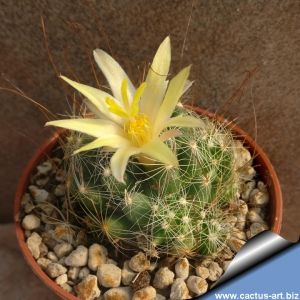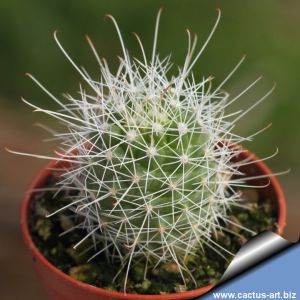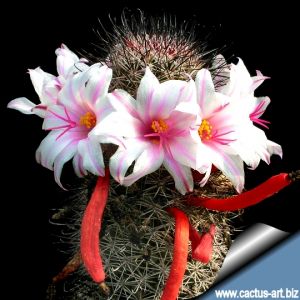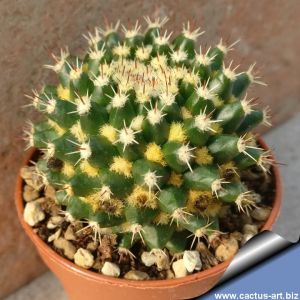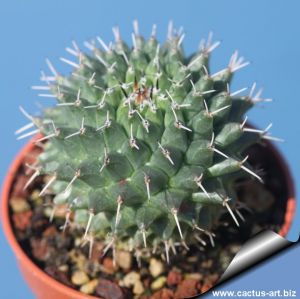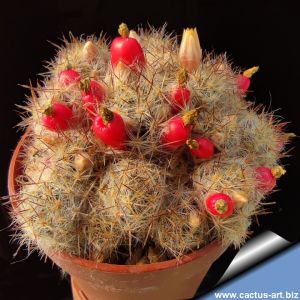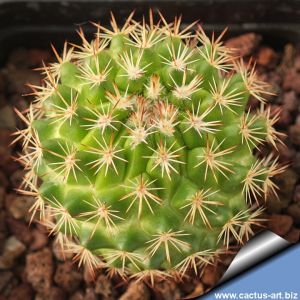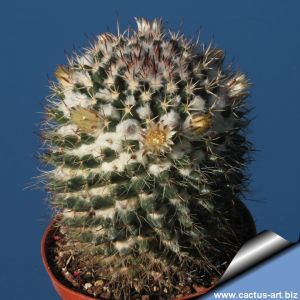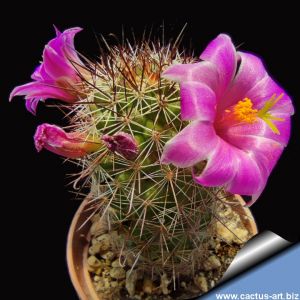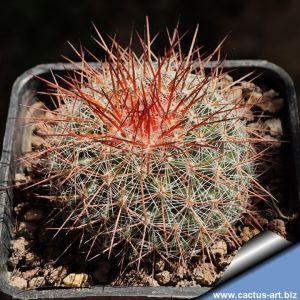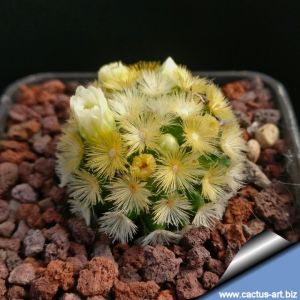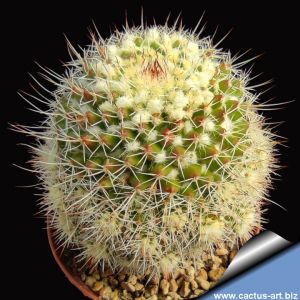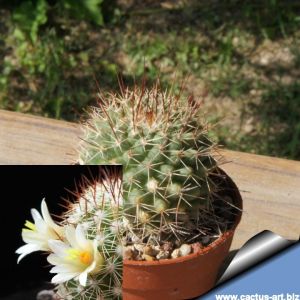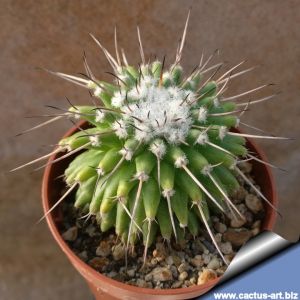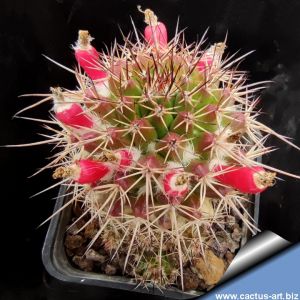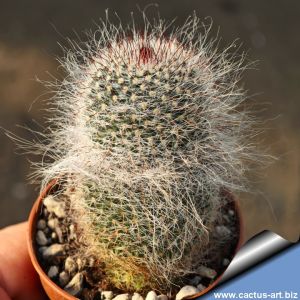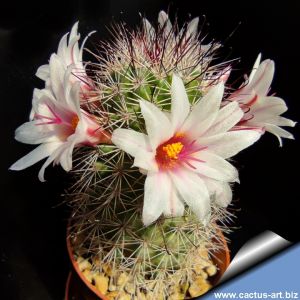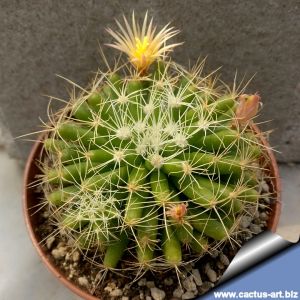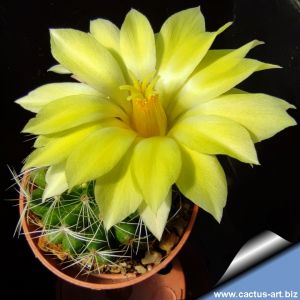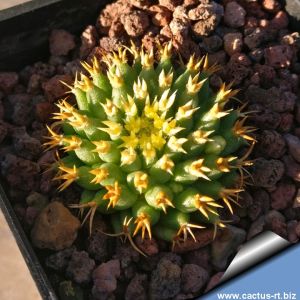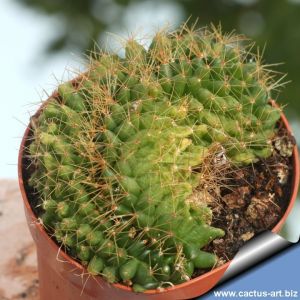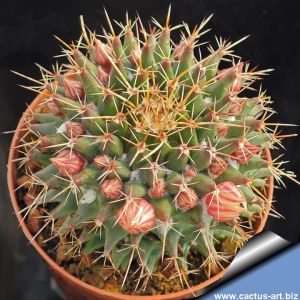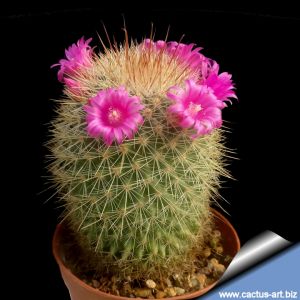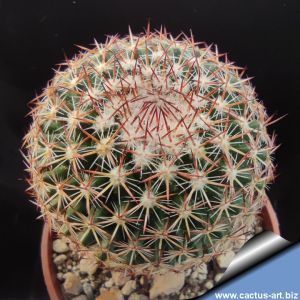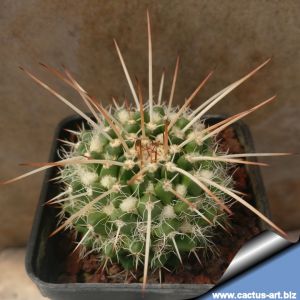-
1
With the uniqueness of the spine patterns this tiny plant is a real gem and one of the most sought-after and distinctive species of Mammillaria. Diameter 1,5-2 cm flowering size!
-
2
Mammillaria theresae is one of the most sought-after and very distinctive species of Mammillaria, this little species is immediately recognisable by its spination even when not in flower. Blooms very large magenta-pink.
-
3
A subtly elegant and refined variety, exceptionally floriferous: pure white flowers arranged in rings near the apex, with creamy-white stamens at their center. A must-have for lovers of white-flowered cacti.
-
4
A stunning clump-forming cactus, growing in bowl-like mounds. Its translucent white radial spines contrast with hooked reddish-brown centrals. Annual blooms form perfect rings of carmine-pink flowers.
-
5
-
6
Slow-growing clumping cactus with soft flattened stems and dense, pale yellow spines with dark bases (up to 120 per areole), arranged in overlapping series. Short, fine, and slightly pubescent — a charming species.
-
7
Seed plants selected for the variegated body. Very beautiful and strange. Variables.
-
8
This plant has some really weird shapes and looks more like some non-cactus succulent or some strange green marine creatures.
It is an easy to grow cultivar, just as a classic cactus, don't requires any special treatment. ROOTTED CUTTINGS.
-
9
A.k.a. Bird's nest Mammillaria, this is a wonderful old favourite cultivar with curly golden-yellow spines. A plant soon forming many heads. The new growth is very attractive, the long, entwining yellowish spines soon form a mat. A real beauty.
-
10
It is a well known cultivar characterized by very reduced or absent spines, free branching, and with small pink flowers.
-
11
-
12
Solitary cylindrical or club-shaped stems, densely covered in short golden spines set in white woolly rings. Pale pink to red-purple flowers encircle the stem apex.
-
13
A sweet little mat forming plant, with long-lasting flowers and ornamental fruits. A very nice addition to any collection!
-
14
"Arizona Snowcap" shows an odd thickening and shortening of the spines, resulting in a most attractive, unusual candid white looking plants.
-
15
-
16
Initially solitary, the stem may branch or divide dichotomously as it matures. Spines spreading, straight, whitish with red-brown tips. Axils are woolly with white bristles. yellowish-white with reddish-browni tips.
-
17
Mammillaria cowperae is the yellow spined form of M. moelleriana. This species has fierce wonderful spines. The white or light pink flowers are produced in spring.
-
18
Mammillaria nivosa is one of the woolliest mammillarias, with beautiful golden-yellow spines. After several rounds of blooms earlier in the year, it produces strikingly bright red fruit. A truly beautiful cactus.
-
19
After several years the old plants divide at their apex, ramifying dichotomously (to form two or more distinct joints) and in 10-15 years they forms small colony. It is a pleasing sight, even in the depths of winter.
-
20
-
21
The dark orange/terracotta pistil is M. pseudoalamensis' trademark, differentiating
it from M. alamenesis' green pistil. Without flowers, the two plants are identical.
-
22
Small clustering species with fine, feathery, flexible, somewhat pectinated, white to almost orange spines. Flowers with pink midstripes at the end of winter in February-March.
-
23
M. schiedeana subs. giselae f. albiflora is a rare cultivar that forms a graceful yellowish-white puff with eventual offsets and nice pure white flowers. It could be a cross between M. giselae and M. carmenae. it is one of the most fascinating cultivars.
-
24
The whole habitat of this plant (discovered only in 1997) disappeared under the water of a man-made dam. It is extinct in nature. The stem covered by numerous hairlike radial spines, giving the plant a shaggy appearance.
-
25
Beautiful plant with showy with white radial spines and hooked red-brown central spines.It bears pink-magenta flowers and grows on steep Mexican rocks, blooming from April to July.
-
26
Flowers wide purplish pink ,style pink with nice green stigma-lobes
Bloomis in April and the flowers remain open for several days (at least three)
-
27
Mammillaria tlalocii is an attractive and rewarding cactus with dense white spines
The slow growth rate make it one of the most sought-after species.
-
28
Compact, rather low body, fast growing, many purple-pink flowers. Forms large emispheric mounds in time.
-
29
This is one of the most beautiful species, with candid white spines and lots of bright purplish-pink flowers, blooming abundantly in spring.
-
30
The tubercles are very pronounced, long, soft and flaccid.
The lemon yellow flowers are very large for this genus (6 cm in diameter ) and are produced in abundance in summer.
-
31
-
32
Smaller than its relative Mammillaria bombycina, this species stands out with dark, hooked central spines and dense, white, pectinate radial spines that cover the stem. It bears pale pink flowers and is regarded as one of the most attractive species.
-
33
Mammillaria marcosi is a beautiful plant with white radial spines and dark reddish-brown centrals. It will slowly forms irregular clumps with dense spination. It may grow up to 25 cm in diameter, with up to 30 heads.
-
34
Clumping cactus, irregularly forming clusters up to 1 m across or more. Flowers large, spectacular, zygomorphic bright scarlet. Not the most easy to grow but worth trying. Be careful with too much water and give it good ventilation. Strong spination.
-
35
M. bocasana var multilanata has round soft stems with an extreme abundance of white woolly hairs and short hooked central spines. The flowers are numerous, large and pink.
-
36
-
37
Flowers are very showy, light purplish-pink with a pinkish brown midstripe and paler margins, about 20-30 mm in diameter. The fruit are club shaped, pale scarlet 25-30 mm long.
-
38
Fred is one of the most famous and bizarre monstrous cactus cultivars, forming soft, rubbery globes in green and pink. It’s a spontaneous mutation, likely originated from a normal Mammillaria bocasana.
-
39
Mammilloydia candida called 'Snowball' is a choice cactus with a so dense snowy white, spination, that its body appears hidden by spines. Mammilloydia are clearly related to the genus Mammillaria, but it is usually recognized as a segregate genera.
-
40
Striking and unusual cactus with large, woolly areoles densely packed with tiny straight spines radiating in all directions. Spines are white or slightly yellowish-red-tipped on new growth, creating a vivid, bristly appearance.
-
41
Soft white spines, rather large yellow flowers with a lemon scent. This rare combination of delicate texture and strong citrus fragrance makes it a standout. A visually and olfactorily appealing cactus.
-
42
A slender columnar species with dense whitish or beige radial spines and one black upward-pointing central spine per areole. Small pink-purple flowers form a crown. It grows in small groups and is valued for elegance and heavy blooming.
-
43
Classic species – Low, globular plant covered in white woolly hairs from the axils. Adorned with charming pink flowers. A collector's favorite.
-
44
Long hooked dark central spine, large pink flower with a characteristic long tube. Rare!
-
45
A tactile wonder with feathery white spines so dense they form snowy angel wings. The cream-colored flowers appear as surprise jewels nestled in the plush spination - a masterclass in nature's softest paradox within the spiny cactus family.
-
46
-
47
-
48
Mammillaria surculosa (Syn: Dolichnthele surculosa) is a low-growing widely spreading cactus forming crowded mats or mounds of small heads and relatively large, bright yellow flowers.
-
49
A small, cereus-like Mammillaria: solitary when young, it forms irregular clusters with age. Stems are hidden beneath dense hooked spines. Showy, long, bright red, zygomorphic flowers are adapted for hummingbird pollination.
-
50
-
51
-
52
-
53
Produces a profusion of red tasty berries without any need of pollination (self-fertile). It will form soon dense mounds with dozen of small stems.
-
54
-
55
Mammillaria voburnensis is a cactus with a distinctive whitish-yellow tomentum near its apex. This species branches out to form clusters up to 30 centimeters in both height and width. The flowers are yellowi
-
56
Mammillaria occidentalis also known as Mammillaria mazatlanensis var. occidentalis is a clumping species which has large pink flowers in summer. The flowers are 1 cm long and are slightly scented. These can be followed by red fruits.
-
57
Mammillaria sinforosensis var. marionae features white radial spines, central spines in reddish-orange or light brown, and soft white wool filling the spaces between tubercles.
-
58
Tight yellow feathery spines.
-
59
Mammillaria nejapensis cv. multiprolifera produces in a short time thousands of tiny, tightly pached stems all around its base.
-
60
Mammillaria multidigitata is endemic to San Pedro Nolasco Island in Mexico, where it growson steep slopes. From spring to early summer it sprouts white to cream colored flowers with yellow-green stigma and orange pollen.
-
61
Mammillaria sempervivi f. montruosa is distinguished by the single long central thorn in each areole. It clumps flat with ground. The white wool between the areoles makes this species a pleasure to look at and grow.
-
62
ammillaria collinsii features white flowers with pink mid-veins, a central spine, and 7 radial spines. Stems grow to 16 cm tall and 9 cm wide, branching from the base to form clumps up to 40 cm in diameter.
-
63
The Mammillaria hahniana f. elongata is distinguished by its stem, which over time develops a short columnar shape. The plant, covered in long white bristles, is strikingly beautiful.
-
64
-
65
-
66
Huge bright yellow flowers.
-
67
Very nice form with 4 (-6) very short orangish radial spines. The younger spines are yellow and very attractive).
-
68
-
69
It thrives alongside Ferocactus echidne REP1139A and Mammillaria priessnitzii REP1134 in its natural environment.
-
70
-
71
-
72
Mammillaria nejapensis is very variable, especially for the length of the spines, that greatly depends on sun exposure and age of the plant. This species forms large colonies by dichotomous division.

